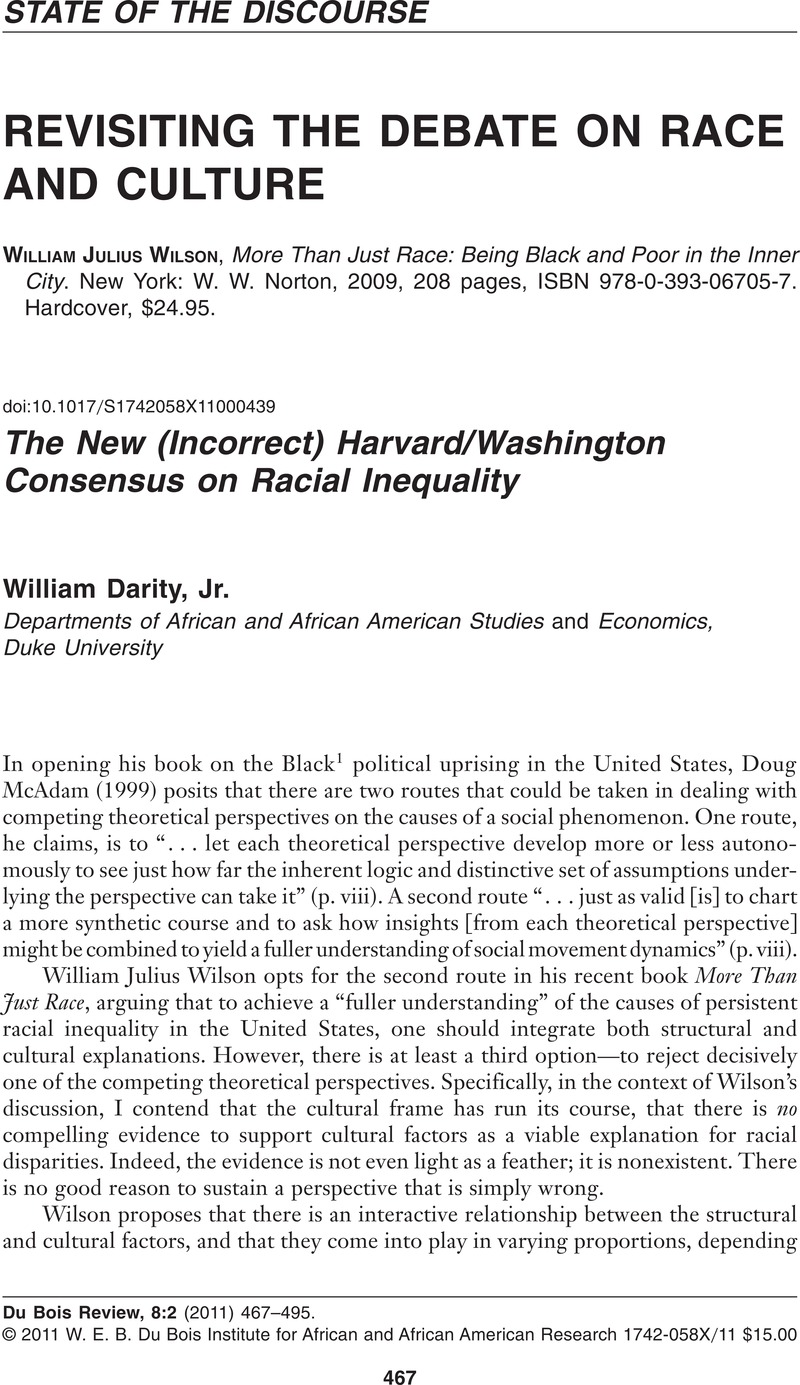Crossref Citations
This article has been cited by the following publications. This list is generated based on data provided by Crossref.
Gans, Herbert J.
2012.
Against culture versus structure.
Identities,
Vol. 19,
Issue. 2,
p.
125.
Hughey, Matthew W.
2012.
Taking culture (and race) beyond dichotomies: a reply to Gans.
Identities,
Vol. 19,
Issue. 5,
p.
639.
Darby, Derrick
and
Saatcioglu, Argun
2014.
RACE, JUSTICE, AND DESEGREGATION1.
Du Bois Review: Social Science Research on Race,
Vol. 11,
Issue. 1,
p.
87.
Seamster, Louise
2015.
The White City: Race and Urban Politics.
Sociology Compass,
Vol. 9,
Issue. 12,
p.
1049.
Ray, Victor
and
Seamster, Louise
2016.
Rethinking racial progress: a response to Wimmer.
Ethnic and Racial Studies,
Vol. 39,
Issue. 8,
p.
1361.
Horowitz, Mark
Haynor, Anthony
and
Kickham, Kenneth
2018.
Sociology’s Sacred Victims and the Politics of Knowledge: Moral Foundations Theory and Disciplinary Controversies.
The American Sociologist,
Vol. 49,
Issue. 4,
p.
459.
Craigie, Terry-Ann
Myers, Samuel L.
and
Darity, William A.
2018.
RACIAL DIFFERENCES IN THE EFFECT OF MARRIAGEABLE MALES ON FEMALE FAMILY HEADSHIP.
Journal of Demographic Economics,
Vol. 84,
Issue. 3,
p.
231.
Christian, Michelle
Seamster, Louise
and
Ray, Victor
2019.
New Directions in Critical Race Theory and Sociology: Racism, White Supremacy, and Resistance.
American Behavioral Scientist,
Vol. 63,
Issue. 13,
p.
1731.
Rendón, María G.
2019.
“There's Nothing Holding Us Back”: The Enduring and Shifting Cultural Outlooks of Inner City Second–Generation Latinos.
City & Community,
Vol. 18,
Issue. 1,
p.
151.
Artiles, Alfredo J.
2019.
Fourteenth Annual Brown Lecture in Education Research: Reenvisioning Equity Research: Disability Identification Disparities as a Case in Point.
Educational Researcher,
Vol. 48,
Issue. 6,
p.
325.
Kreitzer, Rebecca J.
Smith, Candis Watts
Kane, Kellen A.
and
Saunders, Tracee M.
2021.
Affordable but Inaccessible? Contraception Deserts in the US States.
Journal of Health Politics, Policy and Law,
Vol. 46,
Issue. 2,
p.
277.
Artiles, Alfredo J.
2022.
Interdisciplinary Notes on the Dual Nature of Disability: Disrupting Ideology–Ontology Circuits in Racial Disparities Research.
Literacy Research: Theory, Method, and Practice,
Vol. 71,
Issue. 1,
p.
133.
Artiles, Alfredo J.
2022.
Interdisciplinary Inequality Research in the E/BD Field: Animating Intersectionality, Reflexivity, and Equity.
Journal of Emotional and Behavioral Disorders,
Vol. 30,
Issue. 2,
p.
154.
Francis, Dania V.
Hardy, Bradley L.
and
Jones, Damon
2022.
Black Economists on Race and Policy: Contributions to Education, Poverty and Mobility, and Public Finance.
Journal of Economic Literature,
Vol. 60,
Issue. 2,
p.
454.
Tefera, Adai A.
Artiles, Alfredo J.
Kramarczuk Voulgarides, Catherine
Aylward, Alexandra
and
Alvarado, Sarah
2023.
The Aftermath of Disproportionality Citations: Situating Disability-Race Intersections in Historical, Spatial, and Sociocultural Contexts.
American Educational Research Journal,
Vol. 60,
Issue. 2,
p.
367.
Williams, Deadric T.
2023.
Racism and the mechanisms maintaining racial stratification in Black families.
Journal of Family Theory & Review,
Vol. 15,
Issue. 2,
p.
206.
Artiles, Alfredo J.
2025.
Mitigando la dualidad de la discapacidad. Herramientas histórico-culturales críticas para desestabilizar paradojas de equidad.
Revista Española de Pedagogía,
Vol. 83,
Issue. 290,
p.
5.


